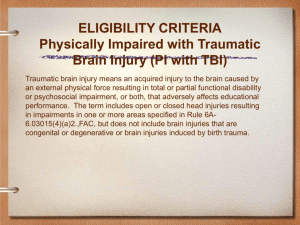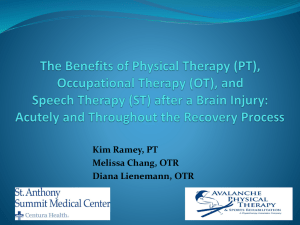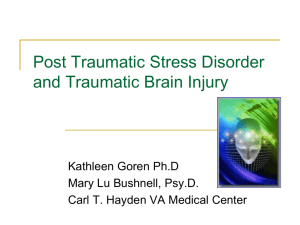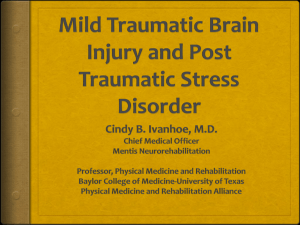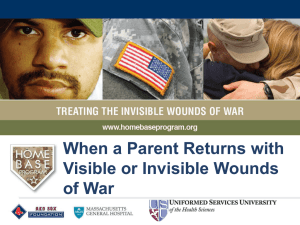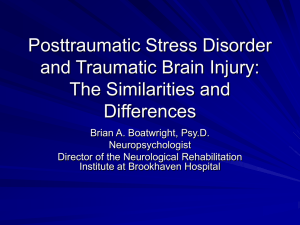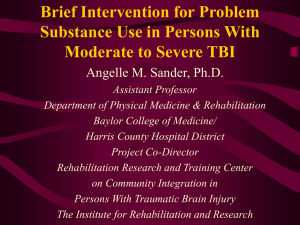TBI, PTSD and Addiction
advertisement
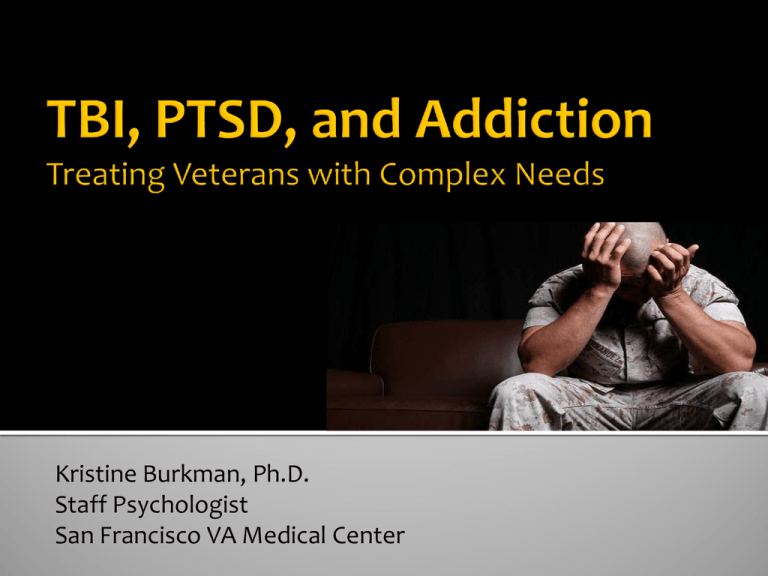
Kristine Burkman, Ph.D. Staff Psychologist San Francisco VA Medical Center ASAM Disclosure of Relevant Financial Relationships Content of Activity: ASAM Medical –Scientific Conference 2013 Name Kristine Burkman, Ph.D. Commercial Interests Relevant Financial Relationships: What Was Received Relevant Financial Relationships: For What Role No Relevant Financial Relationships with Any Commercial Interests X Definitions Assessment Prevalence Overlapping Symptoms Treatment Considerations Suggested Strategies a traumatically induced physiologic disruption of brain function, as manifested by one of the following: Loss of consciousness Loss of memory for events immediately before or after the accident Alteration of mental state at the time of the accident (e.g., feeling dazed, disoriented, or confused) Focal neurological deficit(s) that may or may not be transient American Congress of Rehabilitation Medicine (ACRM) KEEP IN MIND: TBI refers to original injury or etiology, there are no symptoms for this diagnosis Specifiers: Mild, Moderate, Severe Refers to 24-48 hours following injury. Severity of initial injury ≠ impairment in functioning Prognosis often related to: Length of loss of consciousness Length of post traumatic amnesia Eye opening Spontaneous = 4 To speech = 3 To painful stimulation = 2 No response = 1 Verbal response Oriented to person, place & date = 5 Converses but is disoriented = 4 Says inappropriate words = 3 Says incomprehensible sounds = 2 No response = 1 Motor response • • • • • • Follows commands = 6 Makes localizing movements to pain = 5 Makes withdrawal movements to pain = 4 Flexor (decorticate) posturing to pain = 3 Extensor (decerebrate) posturing to pain = 2 No response = 1 SCORING Specifier is based on score within 48 hrs of injury: Severe = 1 - 8 Moderate = 9 - 12 Mild = 13 - 15 Not routinely assessed in combat situations VA assesses via self-report months, even years after the event Screen (4 items, sensitive not specific) Second level eval (22 items) Often not documented and military culture may encourage minimization 91% of OEF/OIF casualties survive1 Compared to 84% of Vietnam, 80% WWII Estimated 22% of returning servicemembers have reported experiencing TBIs and concussions2 Of those injured, approximately 31% diagnosed w/ TBI3 77% of all head injuries are mild TBI4 1Holcomb et al., 2006, 2Terrio et al., 2005, 3Hayward, 2008, 4Fischer, 2010 Persons w/ TBI more likely to have 2nd and 3rd TBI1 Repeat TBIs increase severity and chronicity of symptoms1 Twice as likely to screen positive for PTSD or depression2 Increased risk for suicide3 1Center for Disease Control (CDC); 2Maguen, Lau, Madden & Seal, 2012; 3Brenner, Ignacio & Blow, 2011 Complicated literature Bi-directional relationship between TBI and SUD Pre-injury pattern of substance use predicts post-injury pattern of use Substance use impairs rehabilitation and exacerbates symptoms Increased risk of additional injury Co-Occurring Disorders SUD + Depression, 3-5 time more likely to relapse1 SUD + PTSD relapse more quickly 2,3 Co-occurring patterns of relapse 2, 4 Exposure to Trauma Probability of relapse increases as the # of traumas types increase 5 1Curran et al., 2000; 2Brown et al., 1996; 3Ouimette et al., 1997; 4Curran & Booth, 1999; 5Fraley et al., 1998 Feeling dizzy Loss of balance Poor coordination, clumsy Headaches Vision Problems Sensitivity to Light Nausea Hearing difficulties Sensitivity to noise Numbness Change in taste and/or smell Loss/increase in appetite Difficulty concentrating Forgetfulness Difficulty making decisions Slowed thinking, disorganized Fatigue, loss of energy Feeling depressed or sad Difficulty falling or staying asleep Feeling anxious or tense Irritability, easily annoyed Poor frustration tolerance, easily overwhelmed Re-experiencing Hyperarousal Intrusive images, memories, thoughts Nightmares Flashbacks Emotional distress at reminders Physical reaction to reminders Avoidant Avoiding thinking/talking about trauma Avoiding situations Trouble remembering aspects of trauma Loss of interest in activities used to enjoy Feeling distant/ cut-off from others Emotionally numb Foreshortened sense of future Insomnia Irritability Difficulty concentrating Hypervigilence Startle response Common Challenges Impulse Control Frontal Lobe Inhibited Planning Abstraction Limbic System Activated Judgment Emotion Memory Sleep problems Dizziness Headaches Memory problems Light sensitivity Irritability TBI Depression PTSD Loss of interest Feeling down, hopeless Emotional numbing Avoidance Nightmares Hypervigilence Maguen, Lau, Madden, Seal, 2012 Missed appointments Avoidance, memory problems, difficulty w/ initiation, inability to organize effectively, relapse Difficulty tracking or recalling skills Frustrated w/ pace, embarrassment in session Crisis-prone Relationships, work/school, legal, psychiatric crises Distorted expectations and beliefs Phase Based Model of Recovery Stabilization -Psychoeducation -Coping skills -Psychopharmacology Establish “safety” Improve self-regulation Processing -Construction of narrative -Cognitive restructuring -Exposure Consolidation of memory Habituation of fear response Integration -Interpersonal work -Insight/existential -Symptom maintenance Reconnect with others/life Meaning of experience Titrate level of emotional content re: trauma material Assess level impairment re: memory and emotion regulation to inform when and how to approach trauma processing Fear of symptoms exacerbation Drop out rates Insufficient training for protocol among clinicians “Fragile” patients Chaotic/ high risk situations KEEP IN MIND: Mild TBI should resolve fully within 6 months, debate over cause of ongoing symptoms Integrated treatment of TBI, PTSD and SUD is recommended! Flexibility Persistent outreach Validate, reassure, challenge Acknowledge problems as real to veteran Education re: relapse, heterogeneity of injuries, expectation of recovery from mTBI Goal of recovery not adjustment to permanent disability Multidisciplinary team Harm reduction MEMORY & LEARNING PROCESSING SPEED Write it down Plan Ahead Organize Allow extra time Visualize Info Attach emotion Repetition Accuracy over speed Avoid multitasking Flexible deadlines FRONTAL LOBE DAMAGE Include support members Emotional awareness & management Routine Encourage persistence Keep it simple Go slow Write it down Encourage veteran to communicate back what he/she understands Repeat Thank you for serving our Veterans! Questions? Kristine.Burkman2@va.gov
